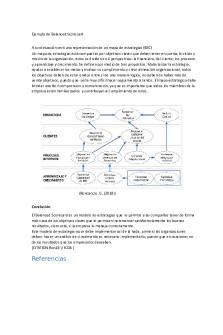Advantage and disadvantage of using balanced scorecard PDF

| Title | Advantage and disadvantage of using balanced scorecard |
|---|---|
| Course | Performance Management and Innovation |
| Institution | Swinburne University of Technology |
| Pages | 2 |
| File Size | 66.6 KB |
| File Type | |
| Total Downloads | 2 |
| Total Views | 155 |
Summary
Summary from lecture learning and for assignment, Summary from lecture learning and for assignment, Summary from lecture learning and for assignment...
Description
Balanced scorecard: The balanced scorecard is a methodological tool meant to help businesses manage their future growth, objectives and plans. The purpose of the balanced scorecard is to give a measuring tape by which someone can determine whether the set goals have been met or exceeded. Advantages: -The first advantage of using the balanced scorecard method is that by looking at four aspects of a company's performance, you really do get a balanced view of company performance. -the balanced scorecard gives you a full picture as to whether your company is meeting its objectives. -While it may seem that a company is doing well financially, it may be that customer satisfaction is down, employee training is inadequate, or that the processes are outdated. -Second, by using a balanced scorecard approach, the immediate future isn't the only thing being evaluated. Often, when an accountant sees the financial bottom line (perhaps the company isn't doing well), suggestions are given that are immediate, but do not look at the long-term. Using balanced scorecards allows for stakeholders to determine the health of short, medium, and long term objectives at a glance. -a company can be sure that any strategic action implemented matches the desired outcomes. Will raising the price of a product help the bottom line of the company in the long run? It might, if the customer is satisfied with that product, or if the processes involved with creating that product make the product of a higher quality. Disadvantages: -First, the balanced scorecard takes forethought. It is not a tool you can just think up one night to solve a problem. Instead, it is recommended that you hold a meeting to plan out what goals you would like to see your company reach in each of the four above areas. Once you have clearly stated objectives, you can then begin to break down these objectives in what you will need, financially, to bring these objectives to fruition. -Second, while the balanced scorecard gives you an overall view of the four areas for concern in business growth and development, these four areas do not paint the whole picture. The financial information included on the scorecard is limited. Instead, to be successfully implemented, the balanced scorecard must be part of a bigger strategy for company growth that includes meticulous accounting methods. -Finally, many companies use metrics that are not applicable to their own situation. It is vitally important when using balanced scorecards to make the information being tracked applicable to your needs. Otherwise, the metrics will be meaningless.
What are the Key Benefits of using Balanced Scorecards? Research has shown that organisations that use a Balanced Scorecard approach tend to outperform organisations without a formal approach to strategic performance management. The key benefits of using a BSC include (see Figure below):
1
2
3
4
5
6
Better Strategic Planning – The Balanced Scorecard provides a powerful framework for building and communicating strategy. The business model is visualised in a Strategy Map which forces managers to think about cause-and-effect relationships. The process of creating a Strategy Map ensures that consensus is reached over a set of interrelated strategic objectives. It means that performance outcomes as well as key enablers or drivers of future performance (such as the intangibles) are identified to create a complete picture of the strategy. Improved Strategy Communication & Execution – The fact that the strategy with all its interrelated objectives is mapped on one piece of paper allows companies to easily communicate strategy internally and externally. We have known for a long time that a picture is worth a thousand words. This ‘plan on a page’ facilities the understanding of the strategy and helps to engage staff and external stakeholders in the delivery and review of strategy. In the end it is impossible to execute a strategy that is not understood by everybody. Better Management Information – The Balanced Scorecard approach forces organisations to design key performance indicators for their various strategic objectives. This ensures that companies are measuring what actually matters. Research shows that companies with a BSC approach tend to report higher quality management information and gain increasing benefits from the way this information is used to guide management and decision making. Improved Performance Reporting – companies using a Balanced Scorecard approach tend to produce better performance reports than organisations without such a structured approach to performance management. Increasing needs and requirements for transparency can be met if companies create meaningful management reports and dashboards to communicate performance both internally and externally. Better Strategic Alignment – organisations with a Balanced Scorecard are able to better align their organisation with the strategic objectives. In order to execute a plan well, organisations need to ensure that all business and support units are working towards the same goals. Cascading the Balanced Scorecard into those units will help to achieve that and link strategy to operations. Better Organisational Alignment – well implemented Balanced Scorecards also help to align organisational processes such as budgeting, risk management and analytics with the strategic priorities. This will help to create a truly strategy focused organisation....
Similar Free PDFs

MAKALAH BALANCED SCORECARD
- 10 Pages

WAL-MART\'S Balanced Scorecard
- 2 Pages

Cumulative Balanced Scorecard 3
- 3 Pages

Ejemplo de Balanced Scorecard
- 2 Pages

Perspectives in Balanced Scorecard
- 11 Pages

Tugas BALANCED SCORECARD
- 13 Pages

Starbucks Balanced Scorecard
- 12 Pages

Balanced scorecard casos reales
- 122 Pages

Balanced Scorecard Test Bank 1
- 6 Pages

Balanced Scorecard Kaplan e Norton
- 11 Pages
Popular Institutions
- Tinajero National High School - Annex
- Politeknik Caltex Riau
- Yokohama City University
- SGT University
- University of Al-Qadisiyah
- Divine Word College of Vigan
- Techniek College Rotterdam
- Universidade de Santiago
- Universiti Teknologi MARA Cawangan Johor Kampus Pasir Gudang
- Poltekkes Kemenkes Yogyakarta
- Baguio City National High School
- Colegio san marcos
- preparatoria uno
- Centro de Bachillerato Tecnológico Industrial y de Servicios No. 107
- Dalian Maritime University
- Quang Trung Secondary School
- Colegio Tecnológico en Informática
- Corporación Regional de Educación Superior
- Grupo CEDVA
- Dar Al Uloom University
- Centro de Estudios Preuniversitarios de la Universidad Nacional de Ingeniería
- 上智大学
- Aakash International School, Nuna Majara
- San Felipe Neri Catholic School
- Kang Chiao International School - New Taipei City
- Misamis Occidental National High School
- Institución Educativa Escuela Normal Juan Ladrilleros
- Kolehiyo ng Pantukan
- Batanes State College
- Instituto Continental
- Sekolah Menengah Kejuruan Kesehatan Kaltara (Tarakan)
- Colegio de La Inmaculada Concepcion - Cebu





